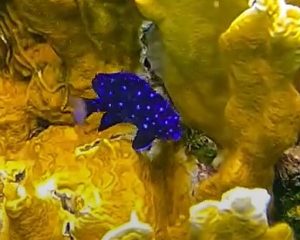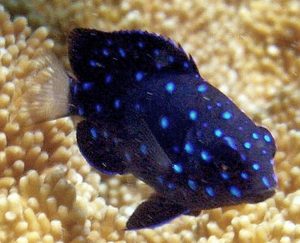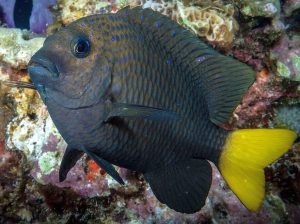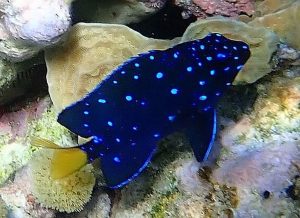Jewel Damselfish (Microspathodon Chrysurus) known to tropical fish keeping enthusiasts as the Marine Jewelfish, Jewelfish, Caribbean Jewel Damsel, Bluespot Damsel, or Yellowtail Damselfish are found in tropical Western Atlantic waters and ranges from Florida, throughout the Caribbean to the Bahamas, south to the coast of Panama.
A similar species, Plectroglyphidodon lacrymatus, found in the Indo West Pacific is referred to as the Pacific Jewel Damsel.
The Jewel Damselfish is a demersal species that is found on inshore and offshore reefs at depths from 1 to as deep as 200 feet during daylight hours. At night they are often found sleeping in caves, crevices, and among staghorn corals. Adults are usually found in the very shallow waters of coral reefs, near the top of the outer edges where there are caves, ledges, holes, and abundant growths of fire coral.
Juvenile Jewel Damselfish have a black to dark blue gray body color, with scattered electric blue dots that become smaller as the fish grow into adulthood. They have a translucent caudal fin that turns bright yellow as the fish ages.
Young adult and adult Jewel Damselfish differ so significantly in terms of body color, that researchers believed
the adult and young adult forms were two distinct species. Adults have a dark yellow brown body, with darker edged scales, and a bright yellow caudal fin. Young adults are violet colored with blue spots on their back and transparent caudal fins. They are a hermaphrodotic species that cannot be easily sexed visually.
Jewel Damselfish (Microspathodon Chrysurus) share the same range and feed on the same benthic microalgae as Stegastes dorsopunicans and Stegastes planifrons.
Juvenile Jewel Damselfish are less aggressive than adults and can be housed in an aquarium of at least 55 gallon capacity with a sandy or coralline substrate and plenty of mature live rock arranged into caves, crevices, holes, and overhangs for them to hide among, and plenty of free swimming space.
Adult Jewel Damselfish or Yellowtail Damselfish are no doubt the most aggressive of all Damselfish and should be kept alone, or in a FOLR aquarium with substantially larger and more robust species. Adults require a much larger aquarium of at least 120 gallon capacity with the same live rock and swimming requirements as juveniles.
Although they are perfectly reef safe and will not harm corals in a reef aquarium; they will intimidate, bully, and attack smaller, more peaceful reef fish species normally housed in that environment.
Jewel Damselfish have been bred in an aquarium environment as well as commercially for tropical fish keeping hobbyists.
Like Blue Velvet Damselfish; the spawning cycle of Yellowtail Damselfish typically begins at sunrise and lasts approximately one hour. During the spring tides between a full and new moon, male Microspathodon Chrysurus begin establishing their nesting sites around a cleaned off section of smooth rock, shell, or piece of coral. The male then courts the female with a “dance” until one accepts him as a mate. Males frequently spawn with several receptive females which deposit their adhesive eggs on the cleaned substrate until the male fertilizes them. Males will constantly aerate the fertilized eggs and carefully remove infertile or diseased eggs as they guard the nest. A single female can lay in excess of 20,000 demersal eggs which hatch out the morning of the sixth day of incubation.
Unlike most other species of Damselfish, total clutch cannibalism by parental males has been observed in Yellowtail Damselfish and has been confirmed by gut analysis. The decision to stop providing care and canonicalize a clutch of offspring by the male could be to reallocate time and energy to attract more mates; or to increase the growth rate or survival of the parents who are in poor condition. Most of the Microspathodon chrysurus clutches that disappear are young, small, first day clutches.
In their natural habitat Adult Jewel Damselfish are selective feeders that graze on a blue-green algae called cyanophytes. Juveniles are typically carnivores that gradually change their feeding habits throughout their development. As young adults, they primarily feed on animals like nematocysts and zooxanthellae.
In an aquarium environment with plenty of mature live rock in the system, Jewel Damselfish should be fed a variety of meaty foods like vitamin enriched shrimp, Mysis, brine shrimp
, krill
, scallops, clams, plankton, or a frozen omnivore preparation. They will also readily accept flake and pellet foods. Its always best to feed several small portions throughout the day.
Jewel Damselfish (Microspathodon Chrysurus) are extremely hardy and available to tropical fish keeping enthusiasts from tropical fish shops and a multitude of online sources. Juveniles are more commonly available at a purchase size as Mediums: 2″ to 3″.
Minimum Tank Size: 55 gallons for single or pair/ 120 gallons for community
Aquarium Type: Reef, FOLR
Care Level: Easy
Temperament: Very Aggressive
Aquarium Hardiness: Very Hardy
Water Conditions: 72-78°F, dKH 8 to 12 , pH 8.1 – 8.4, sg 1.020-1.025
Max. Size: 6″
Color Form: Black, Electric Blue, Yellow
Diet: Omnivore
Compatibility: Aggressive Fish Only
Origin: Western Atlantic
Family: Pomacanthidae
Lifespan: 5 years
Aquarist Experience Level: Beginner






One Response to “Jewel Damselfish (Microspathodon Chrysurus)”
Trackbacks/Pingbacks
[…] Jewel Damselfish (Microspathodon Chrysurus), Pomacentrus pavo are oviparous and form up into distinct pairs before mating. Male damselfish […]